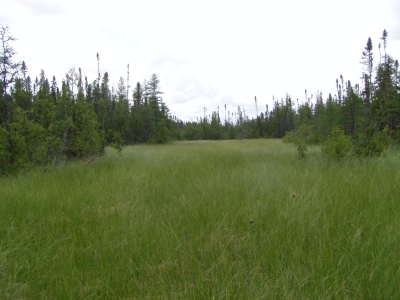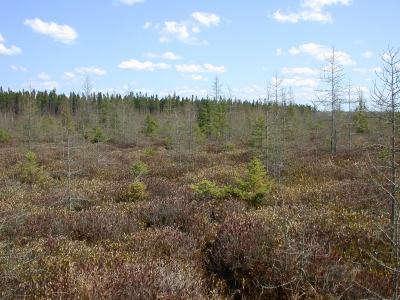Why do Peatlands Matter?
Peatlands store up to 30% of the world’s terrestrial carbon (C) despite occupying just 3% of the terrestrial land surface; they also represent a huge source of carbon that is at risk of being released by runaway climate change at current rates of warming. They therefore play a critical role in the global carbon cycle.
A peatland is a type of wetland ecosystem characterized by the natural accumulation of organic matter derived from decaying plant material (peat) under permanent water saturation. Peatlands are dominated by actively forming peat and usually contain a foot or more of accumulated peat. The most common peatland plant communities in Minnesota are bogs, which are fed mainly by rainfall, and fens, which are fed mainly by groundwater. These broad categories include many unique landforms, including the raised bogs and patterned fens found in a number of Scientific and Natural Areas.
Minnesota has more peatlands – over 6 million acres – than any other state outside Alaska. However, many of these lands were ditched and drained in the past for farming or other purposes. Drained peatlands lose significant amounts of carbon as they decompose due to exposure to oxygen and microbial decomposition, and they also provide opportunities to sequester carbon after restoration as peat layers regenerate.
It’s estimated that approximately 600,000 acres of peatland are still being impacted/degraded by past attempts at drainage for agriculture or forestry but are not currently farmed, while another 300,000 – 400,000 acres are currently farmed or grazed. These cultivated soils, rich in organic matter, emit an estimated 11 million metric tons of carbon dioxide and nitrous oxide per year, making them the single largest source of emissions reported by the Minnesota Pollution Control Agency in the “Agriculture, Forestry and Land Use” sector.
The Minnesota Climate Action Framework identifies peatland protection as a high priority under the Natural and Working Lands goals and strategies:
Protect, restore, and manage peatlands and other wetlands - Peatlands (bogs and fens) hold some of Minnesota’s largest carbon reserves, but emit large quantities of carbon when ditched and drained. Protecting existing peatlands and other wetlands, and restoring drained, farmed or pastured peatlands and wetlands will increase carbon storage.
A Mapping Tool for Identifying Potentially Restorable Peatlands
The purpose of this tool is to identify peatland soils that have been completely or partially drained and that may be suitable for restoration, to reduce carbon loss and maximize carbon sequestration. Restoration potential will depend on many factors, including current land use and ownership, available funding sources, and technical feasibility, and will require a thorough site-level evaluation. BWSR has worked closely with The Nature Conservancy and U.S. Forest Service researchers to develop this tool, and appreciates their work in developing estimates of drained and farmed peatland acreage, as well as the Histosol and Soil Organic Carbon data layers.
Potentially Restorable Peatlands Mapping Tool
The mapping tool is still evolving, and BWSR staff welcome comments and suggestions for improvement. Please contact staff listed below with your ideas.
How to Use the Mapping Tool
The map will initially appear with only county boundaries and histosols (the main type of peatland soils) shown. Use the Layer List icon to add additional layers, move layers up or down, or to review descriptions of any layer. Use the Legend icon to view a legend showing the currently visible layers. Base maps can be changed using the Basemap Gallery. You can use the search window to search for an address, a county, or another mapped feature. Because of the number of layers available, you may need to focus on only a few at a time while exploring the map. The drop-down section below provides detailed descriptions of the source of each layer.
- Data Layers and References
Histosols – Histosols are defined by the Natural Resources Conservation Service as “soils that are dominantly organic … commonly called bogs, moors, or peats and mucks. A soil is classified as Histosol if it does not have permafrost and is dominated by organic soil materials."
According to the NRCS Illustrated Guide to Soil Taxonomy (2022), histosols are formed in thick accumulations of organic material from decaying plant material. The organic-dominated layers are typically at least 40 cm (~16 inches) thick, with a minimum of 12 to 18% organic carbon by weight (depending on clay content). Histosols do not exhibit the kinds of horizons common to mineral soils but rather have layers, or tiers, that vary in color, botanical origin of the organic material, amount of mixed-in mineral soil material, degree of decomposition, and other properties. Histosols generally have significantly lower bulk density and higher nutrient- and water-holding capacities than most mineral soils.
(Note: Soils data are missing in much of Pine County and in smaller areas of Lake and Cook counties. BWSR is working with other state and federal agencies to improve this coverage.)
The Minnesota Wetland Inventory is a publicly available GIS database that provides information on the location and characteristics of wetlands in Minnesota. It is based on the framework for the National Wetlands Inventory (NWI). These data are used in wetland regulation and management, land use and conservation planning, environmental impact assessment, and natural resource inventories. The NWI is a planning and assessment tool, not a jurisdictional wetland determination. There are many ways to define wetlands. While the layer shown here combines all wetland types into one category, the full NWI incorporates four different wetland classifications, based on factors such as plant community, type of habitat, water regime and landscape position. Location and extent of all wetlands should be verified through site inspection before any action is taken that could affect the wetland.
There may be some overlap between the Restorable Wetlands Index and the NWI because the NWI includes some farmed or partially drained wetlands that are potentially restorable.
Public Ditches – This layer is drawn from Minnesota's Public Waters Inventory (PWI), a dataset provided by the Department of Natural Resources. Additional ditches may appear on the map as linear breaks; these may be private ditches or other ditches that have been abandoned.
BWSR RIM (Reinvest in Minnesota) Reserve Easements – This layer depicts the approximate boundaries of lands protected by State of Minnesota conservation easements. Boundaries should be considered approximate and do not necessarily represent survey grade data. The objective of the RIM Reserve program is to restore marginal agricultural lands and protect environmentally sensitive areas. In cooperation with county Soil & Water Conservation Districts (SWCDs), BWSR's easement programs compensate landowners for granting conservation easements and establishing native vegetation habitat on economically marginal, flood-prone, environmentally sensitive or highly erodible lands.
BWSR Wetland Banking Easements – This layer identifies all wetland bank sites managed through the state wetland banking system and administered by BWSR. Minnesota's wetland banking program includes both private and state-sponsored wetland banks which have "credits" that are used to offset (mitigate) authorized wetland impacts. As with RIM easements, boundaries are considered approximate and do not necessarily represent survey grade data.
Cropland Data Layer (CDL) – This layer is maintained by the U.S. Department of Agriculture, National Agricultural Statistics Service. It uses satellite imagery to provide acreage estimates for major commodities. The full dataset is found on the CropScape website. The CDL is updated annually. Note that the legend for this category is simplified to include only those crops grown in Minnesota.
Government Ownership Parcels – This layer was developed and supplied by the Minnesota Department of Natural Resources. It includes lands owned or managed by federal, state, county, regional and municipal governments. State-managed land includes school trust lands and consolidated conservation "con-con" lands. Tax forfeit lands are held in title by the state but generally managed at the county level. For further details, see the DNR's "Minnesota State Land Portfolio" webpage.
Restorable Wetlands Inventory – A dataset developed by the Natural Resources Research Institute (NRRI) that represents a statistically-based model of restorable wetlands statewide based on topography and other variables. The 2019 update, based on increases in the quality and resolution of environmental spatial data and computer processing capabilities (i.e., Random Forest modeling, a machine learning technique used for classification), represents the likelihood of an area being a wetland or a restorable wetland across the state of Minnesota at a resolution of 3 meters. Location and extent of all wetlands should be verified through site inspection before any action is taken that could affect the wetland.
Soil Organic Carbon – This layer, developed by The Nature Conservancy, shows a weighted average (g C/m2) of soil organic carbon from the USDA-NRCS gSSURGO (gridded Soil Survey Geographic) database (October 2021). It largely coincides with the Histosols layer.
Sample Searches
The document below provides examples of how to identify potentially restorable peatlands in several regions of Minnesota. In general, start by looking for histosols that do not overlap with the National Wetland Inventory and that may be in agricultural or other land uses. As noted above, these searches are only a first step: assessing the restoration potential of a site will depend on many factors, including the depth of organic matter, dominant plant communities, hydrology, current land use, and landownership.
Sample Searches for Restorable Peatlands (pdf)


